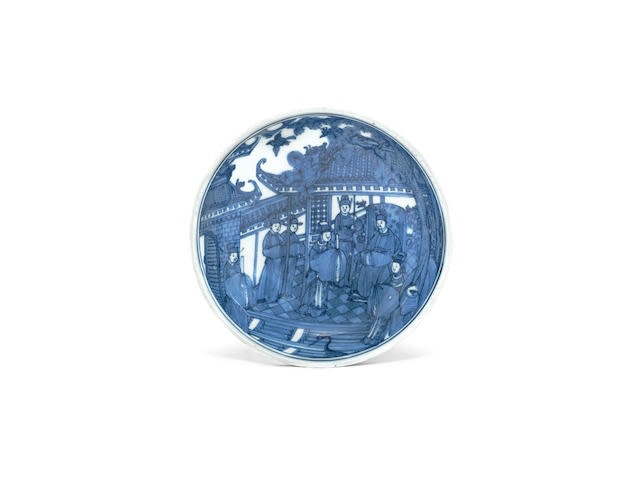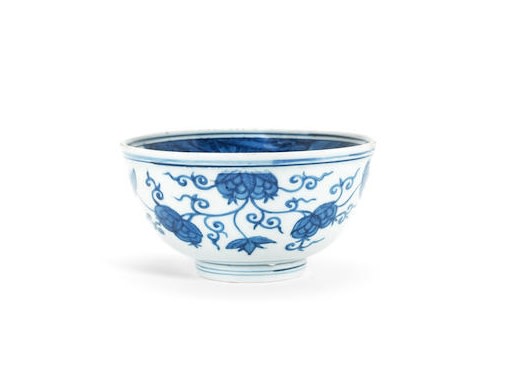Of round form, and hollow interior, the concave upper surface of the bowl exquisitely painted in shades of cobalt blue with a high official seated on a throne in front of a screen, surrounded by standing attendants and being greeted by a gentleman holding a ruyi sceptre paying obeisance, another gentleman also holding a ruyi sceptre follows behind him, all taking place in a pavilion intricately designed, the roof with ridge tiles of fantastic beasts and to the side an old prunus tree, a bird flies in the sky above and in the foreground at the bottom of the scene a crane lurks, the exterior wall of the bowl painted with scrolling sprays of fruiting melon and squirrels between double blue lines at the mouth rim and foot, the glazed base with a circular aperture surrounded by the four character mark Lu shi wan chung.
Literature
These double-walled warming bowls were made to hold medicine and food and produced by joining together two bowls of slightly different sizes. The outer bowl commonly had a circular hole at the foot to allow hot water to fill the cavities between the two bowls and keep the vessel and its contents warm.
Of the published blue and white warming or hot water bowls, each is different in its decoration, some with figural decoration, others with floral, and sometimes, as with the present example, with seemingly unrelated decoration on the sides and warming surface.
Another warming bowl with narrative scenes on the interior and outside walls dated 1540-1560, is in the British Museum, museum number PDF.670, and a further warming bowl in the British Museum decorated with a figure on the inside and lingzhi sprays on the outside and dated to c.1573-1620, is illustrated in J. Harrison-Hall, Ming Ceramics in the British Museum, London 2001, p. 309, 11:87.
Two dated to the late 15th century in the Percival David Foundation are illustrated by M. Medley in the Catalogue, London, 1976, Section 3, pl. VI, no. A623 and pl. IV, no. 696. Like the present bowl, the exterior of the first is encircled by lotus scroll, but the decoration on the interior is of fish dragons amidst water weeds, while the other bowl has figural scenes allover.
Educated at Winchester and New College, Oxford, Arthur Spriggs was a distinguished medical scientist for much of his very long life. He held a number of senior positions at Oxford's Radcliffe Infirmary and Churchill Hospital where he lectured and published extensively in his specialist field of cancer research. His early published research was accompanied by illustrations of cell preparations carefully drawn (using a microscope) by his accomplished water-colourist wife Gereth. Later in his career he pioneered the use of electron microscopy in the observation of chromosome anomalies and the detection of cancers, establishing the first regional screening service.
Arthur's personal interests extended to botany (he created and maintained a large 'natural' garden at his home); molluscs and snails (an indefatigable field worker, he must have surveyed every square kilometre of Oxfordshire during his long but active retirement); and, of course, Chinese porcelain, especially 17th century blue and white. A keen supporter for many years of the London-based Oriental Ceramic Society, he presented a ground-breaking lecture in 1965 which documented certain types of Chinese and Japanese porcelain featured in Western paintings between AD 1450-1700. Published in the 'Transactions', Vol.36, it stimulated further investigation into the handsome 'vanitas' oil paintings which greatly enhanced the houses of successful Netherlandish burghers during the 'Dutch Golden Age'.




